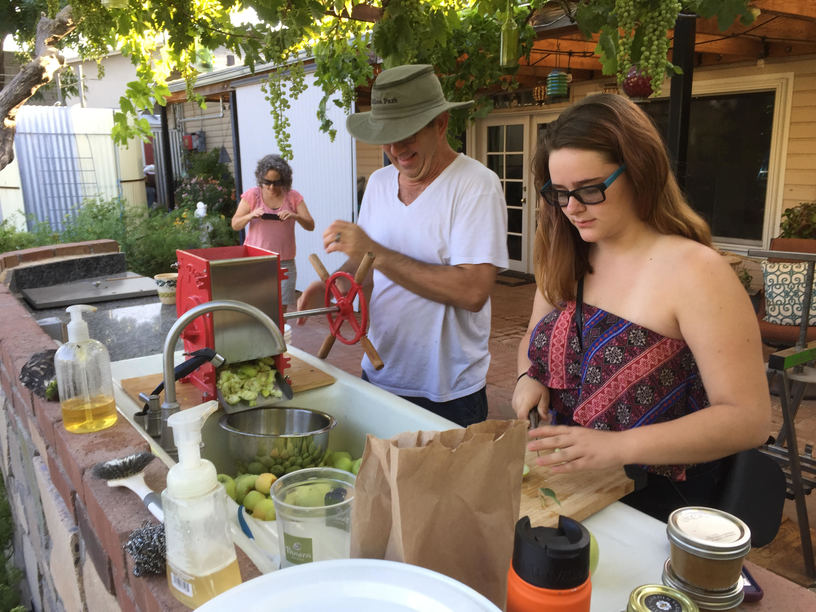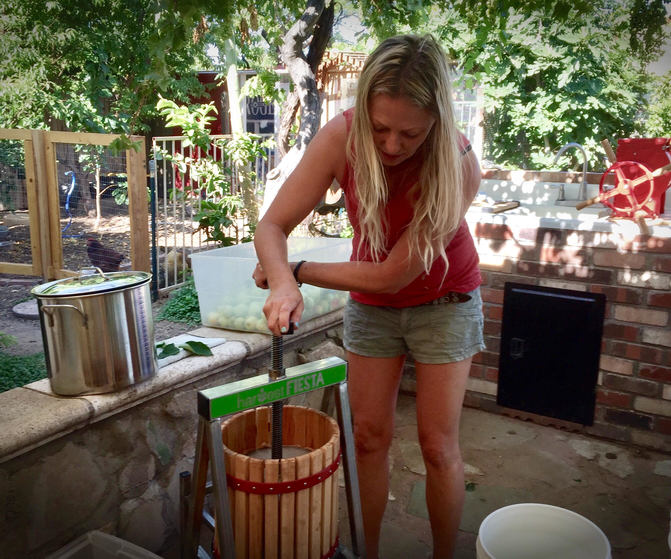How to Make Apple Wine
By Cricket Aldridge
A couple weeks ago, Greg graciously invited Kari Spencer and me over to share some of his apple trees’ incredible bounty. We started the morning by pulling out ladders and picking the apples, handful by handful. That is, until Greg decided to shake the tree and, in one magical moment, it rained apples and we were all laughing at the fun of it. Needless to say, we had more than enough apples for our project. Our plan was to wash, crush, and juice the apples for making apple wine.
So, once we had all the apples in buckets we took them over to Greg’s amazing outdoor kitchen where he had the crusher set up at the sink and the juicer ready a few feet away. We kept the largest apples out for making apple chips, but the rest we juiced. We determined that every 5 gallons of apples made 1 gallon of the most amazing apple cider you could imagine. A couple hours of sharing stories and building our apple-crushing muscles (ok, Greg did most of that), and we had enough juice.
Greg only kept 1 gallon, while I headed home with 4, plus a tub of apple scraps for drying.

Making Apple Wine
As soon as I got home I assembled my wine-making ingredients and got to work.
I followed EC Krause’s recipe for apple wine, which calls for the following ingredients for every 1 gallon:
- 1 Pound of Cane Sugar
- 1 Teaspoon of Yeast Nutrient
- 1/8 Teaspoon of Pectic Enzyme
- 1-1/2 Teaspoon of Acid Blend
- 1/4 Teaspoon of Wine Tannin
- 1/8 Teaspoon of Ascorbic Acid
- 1 Campden Tablet (crushed and dissolved)
- 1 Package of Lalvin EC-1118 wine yeast for every batch up to 5 gallons.

You can get the detailed instructions here. Basically, you mix everything but the yeast together in a bucket, cover with a towel and let sit for 24 hours. The Campden tablets kill any wild yeast or bacteria that is in the cider so that only the Lalvin EC-1118 yeast will be fermenting your wine.
Basically, you mix everything but the yeast together in a bucket, cover with a towel and let sit for 24 hours. The Campden tablets kill any wild yeast or bacteria that is in the cider so that only the Lalvin EC-1118 yeast will be fermenting your wine.
After 24 hours, add the Lalvin-EC1118 yeast, place the towel back over the bucket, and leave for 4-5 days to ferment. It should bubble and foam in that time, but then mostly stop. That is called the Primary Ferment. You will use a hydrometer to check the specific gravity (learn more about that here).
At this point you need to have a sterilized 4-5 gallon carboy and siphon. Everything that touches the wine at this point must be sterilized using a bleach solution or other specialized sterilizers to keep from contaminating the wine.
Siphon the wine, leaving most of the sediment into the carboy and leave for a few weeks, with an airlock in place. When the wine has cleared, you will use another dose of Campden tablets, bottle the wine into sterilized bottles, and cork. That’s it.
Note: Please read the entire instructions from EC Kraus to get all the details and use their resources for any help you need. Also check out their other wine recipes.
But wait! What about the apple scraps?
This is the easiest part of all. I decided I would dehydrate the scraps, seeds, stems, peels, and all to turn into apple powder. I love putting this in cereal, popcorn, pancake batter, smoothies, and so much more!  The great thing about these scraps is that they have been pressed to the point of being already quite dry, so dehydrating takes less time (unless you forget about them for a few days, which is fine in our Arizona heat).
The great thing about these scraps is that they have been pressed to the point of being already quite dry, so dehydrating takes less time (unless you forget about them for a few days, which is fine in our Arizona heat).
I just spread them all out on my dehydrator trays and set the dehydrator to 135° F for about 12 hours. Honestly, I could have just put them in the dehydrator and left them with it turned off since I have it outside. This heat would have done the job nicely without electricity.
When finished, it should be dried to a crisp so with no moisture at all.
Then, I just use my coffee grinder or blender to turn it into a fine powder to be stored in a vacuum sealed bag or jar for use in all kinds of yummy ways. Zero waste!







As to your comments on self-sufficiency Traditionally, farmer’s social life came from end of the month barn dances, harvest parties, trading the use of equipment Helping your friend harvest apples. The women sitting with other women prepping food for canning. Inner dependent self-sufficiency would be a better way of saying it.